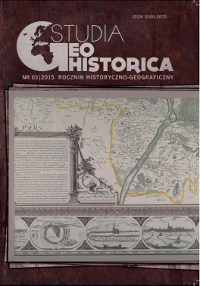Powiat kcyński w drugiej połowie XVI w.
The District of Kcynia in the Second Half of the 16th Century
Author(s): Marta Piber-ZbieranowskaSubject(s): Regional Geography, Maps / Cartography, 16th Century
Published by: Polskie Towarzystwo Historyczne
Keywords: powiat kcyński;województwo kaliskie;rejestr poborowy;Wielkopolska w XVI w.;osadnictwo;Atlas historyczny Polski;Kcynia district;Kalisz Voivodeship;tax register;Greater Poland in the 16th century,
Summary/Abstract: In the second half of the 16th century, the district of Kcynia was administratively a part of the Kalisz voivodeship, which also comprised the districts of Kalisz, Pyzdry, Konin, Gniezno and Nakło. Th e district of Kcynia was situated in the northern part of the voivodeship, from the north bordering the district of Nakło and from the south the district of Gniezno. It constituted a part of the Kalisz voivodeship since 1768, when three northern districts were separated from that voivodeship, namely of Gniezno, Kcynia and Nakło – thus establishing the Gniezno voivodeship. The source basis of the reconstruction of settlement, together with state and church administrative divisions in 1600 are the so-called tax registers, which were the lists of incomes from the extraordinary tax temporarily passed by the Seym of the Republic of Poland for military purposes. In the second half of the 16th c. it acquired a common character, including all categories of the population and industrial facilities functioning in rural and urban areas. The censuses were performed according to the administrative division into voivodeships and districts as well as parishes inside them. For the second half of the 16th c. eleven tax registers of the district of Kcynia have been preserved from the years 1564–1591, at present kept in the Central Archives of Historical Records in Warsaw. Data from the registers are supplemented with the information from other sources, first of all ecclesiastical ones. The settlement network of the district of Kcynia was mostly shaped already in the period of the Middle Ages (13th–15th centuries). The number of new settlements in the 16th c., especially in the second half, was already small. In the period under discussion the district of Kcynia comprised 2400 km2 and the number of identified settlement sites can be determined at 317, which means that one settlement included approximately 7.5 km2. In that time there were 13 towns in the area of the district, the biggest being Żnin, which belonged to the archbishop of Gniezno and which had 2500 inhabitants. The population of the district capital Kcynia, the seat of the starost (overseer of the Crown lands), can be estimated at about 1000 persons. The district of Kcynia mostly included small rural settlements with the area not exceeding 10 lans (a unit of field measurement) of arable land plus the manor lands. The area of the arable land (except the manor lands) in the district of Kcynia was at that time about 340 km2, which was a little more than 14% of the whole area of the district. The total size of the usable area can be estimated at only 30% of the whole district area, while the rest included forests and waste land. The gentry property clearly predominated, constituting about 79% of the whole estate, while 18% was church property and only 2% of the lands belonged to the kind, while 1% was a mixed property. It can be stated on the basis of the sources that in the district of Kcynia at that time nearly 40 watermills and more than 50 windmills functioned and they were concentrated in the central part of the region with the least forestation. The area of the district of Kcynia in the period under discussion was divided between three dioceses, namely of Gniezno, Poznań and Wrocław. Most of the area belonged to the archdeanery of Gniezno of the Gniezno archdiocese and within it, to three deaneries: of Łekno, Żnin and Gniezno-St. Peter. Forty one parishes had their seats in the area of the district.
Journal: Studia Geohistorica
- Issue Year: 2015
- Issue No: 3
- Page Range: 89-109
- Page Count: 21
- Language: Polish

